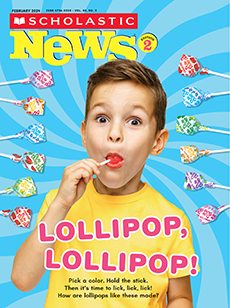We're in This Together Lesson Plan
Academic Standards
Reading Objective:
Children will learn about peaceful protests and how they work, both in Dr King’s time and today.
Social Studies Focus:
Dr. Martin Luther King, Jr.
ELA Skills:
key details, writing, opinion writing, vocabulary, text features
Page 4 Skill:
read a timeline
Vocabulary:
laws, segregation, peaceful, protests
CCSS:
RI.2.1, RI.2.4, RI.2.10, L.2.1, W.2.1, W.2.8, SL.2.3
Guided Reading Level:
N
Lexile Level:
480L
Before teaching the lesson, download and read the note from the editors here. It will get you ready to teach the lesson with confidence.
Provide students with some background on Dr. King.
Build background knowledge (10 min.)
- Watch our video “Dr. King: A Leader and a Hero.” After children have finished watching the video, ask them why they think people call Dr. King a hero.
Preview vocabulary (3 min.)
- Next, play the online vocabulary slideshow. This issue’s featured words are laws, segregation, peaceful, and protests.
Set a purpose for reading (5 min.)
- Pass out the issue, and discuss the cover. Ask kids why they think Dr. King is marching with other people, rather than by himself.
- Next, read the As You Read prompt on page 2: “Think about why it is helpful to work together.” Encourage children to think about this prompt as they read.
Read together (20 min.)
Pass out the Read and Think printable. Use it to check comprehension as you read the issue together, pausing to ask the questions.
Questions Kids Might Ask
- About why protests are going on today: Try to find out how much kids already know and meet them where they are. Ask questions such as, “What have you heard about this? Have you seen anything on TV or heard your family talk about it?” A simple explanation might be: It’s not OK to hurt people. Some Black and brown people were hurt and killed. People are sad and angry about it. They want it to stop happening.
- About the Dr. King timeline on page 4: Some kids might be curious about the line “he was killed.” If they ask, you can be honest and factual about what happened: Dr. King was shot while standing on the balcony at a hotel.
- The Design a Poster game lets students review text features as they make a digital poster in honor of Dr. King. They can even print it out.
You can use our printable worksheets to focus on important ELA skills. Here’s how.
ELA Focus: Vocabulary (15 min.)
- Use the Word Work printable to deepen students’ understanding of the words laws, segregation, and protests.
Editor’s Pick: Make Your Own Sign (15 min.)
- The Make a Mini Sign skill sheets let students share the causes they care about, from school lunches to helping animals. Some kids may want to write about the more “grown-up” topics of today—and that’s great too! If they have the knowledge, they should share their message.
- You can hang students’ signs outside the classroom, or students can hang them in their own windows at home.
ELA Focus: Nonfiction Text Features (15 min.)
- The Text-Feature Hunt printable is a great way to help students recognize and use nonfiction text features, including headlines, subheadings, photos, and bold words. Children can hunt for each text feature in the magazine, circle it, and then fill in the answers on the sheet.
Assessment: Reading Checkpoint
- Pass out the Reading Checkpoint to review key concepts from the issue and assess students’ proficiency on key nonfiction reading skills.
Here are two past issues you can use to extend your lesson on Dr. King:
- A Hero’s Story, January 2018. This issue tells a story from Dr. King’s childhood that led him to becoming the great leader he was.
- A Hero in the Family, January 2019. In this issue, Dr. King’s granddaughter, Yolanda, introduces her heroic grandfather.
You can find a higher-Lexile-level and a lower-Lexile-level version of the article online here:
- Higher-Lexile level: 550L
- Lower-Lexile level: 450L
